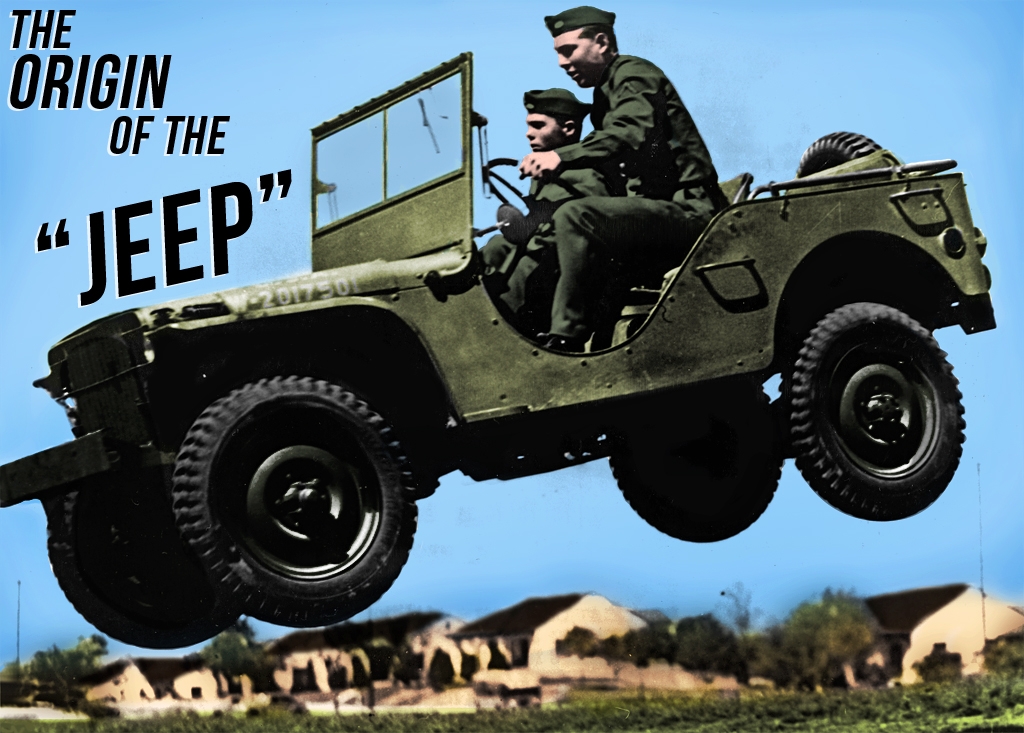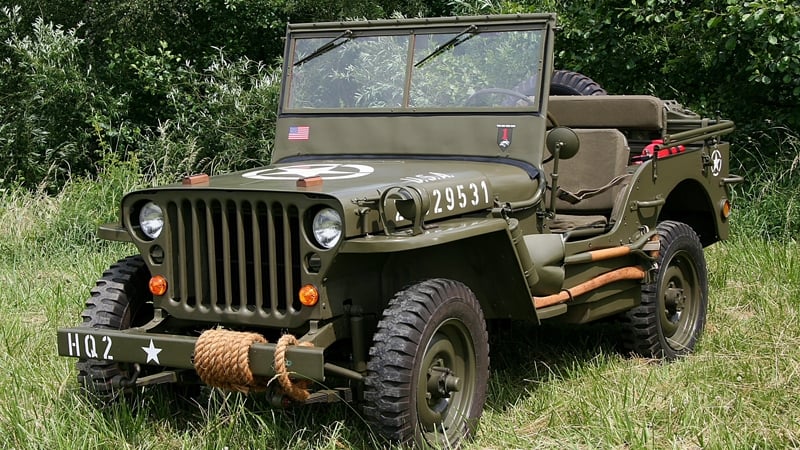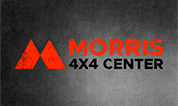 There are some things that just can't be fully explained, like the mysteries of the universe, or where the name "JEEP" actually comes from. Sure, there are stories, articles, rumors. With many an hour spent sitting around campsites and fishing trips, debating on how the name came about. If you're new to Jeeps, meaning, you just picked up that JK Wrangler Rubicon from the dealership, and you're ready to make some new Jeep friends, you may not know the history, or stories, of the name "Jeep". So let's grab a can opener and open this can of worms right now ... We're not saying we solved the mystery. All we can do is give you some clues and a map, and you have to decide which one might be the answer. But the exploration into the origin of the name Jeep is a fun one. Let's see how the names evolved: To start this journey, we have to go all the way back to 1940. At this time, the military vehicle was just being designed and contemplated by the U.S. Army (though, back then, all the military branches were one big organization). They needed a vehicle that was standard, meaning, a vehicle that would primarily use the same parts, but could be used in different ways in a war. A bid was sent out to about 135 car manufacturers to come up with such a vehicle. (Note that unlike today, there were many more car companies back then, like Hudson, Marion, Stutz, Thomas, etc. From 1896 to 1930 alone, there had been over 1800 separate car companies!). Car manufacturers were given only 49 days to submit a prototype vehicle. That's with no CAD drawings, no computers, no modern tooling. They had to design and BUILD an actual running vehicle in that time.
There are some things that just can't be fully explained, like the mysteries of the universe, or where the name "JEEP" actually comes from. Sure, there are stories, articles, rumors. With many an hour spent sitting around campsites and fishing trips, debating on how the name came about. If you're new to Jeeps, meaning, you just picked up that JK Wrangler Rubicon from the dealership, and you're ready to make some new Jeep friends, you may not know the history, or stories, of the name "Jeep". So let's grab a can opener and open this can of worms right now ... We're not saying we solved the mystery. All we can do is give you some clues and a map, and you have to decide which one might be the answer. But the exploration into the origin of the name Jeep is a fun one. Let's see how the names evolved: To start this journey, we have to go all the way back to 1940. At this time, the military vehicle was just being designed and contemplated by the U.S. Army (though, back then, all the military branches were one big organization). They needed a vehicle that was standard, meaning, a vehicle that would primarily use the same parts, but could be used in different ways in a war. A bid was sent out to about 135 car manufacturers to come up with such a vehicle. (Note that unlike today, there were many more car companies back then, like Hudson, Marion, Stutz, Thomas, etc. From 1896 to 1930 alone, there had been over 1800 separate car companies!). Car manufacturers were given only 49 days to submit a prototype vehicle. That's with no CAD drawings, no computers, no modern tooling. They had to design and BUILD an actual running vehicle in that time. 
"Blitz Buggy"
Two companies stepped up with entries, American Bantam Car Company, and Willys-Overland Motors (Ford Motor Company entered later). While no official name or designation was given to the vehicle yet, Bantam nicknamed the new vehicle the "Blitz Buggy". (I guess we're lucky the Army didn't stick to that name. Especially since "blitz" was a German term). This first vehicle, in today's age, is sometimes referred to as "Old Number One". (Though I wasn't able to determine if the prototype still exists.)"Pygmy" / "Quad" / "BRC 60-Mark II"
By the time testing had begun (still in 1940), Ford was in the race, and entered it's Ford "Pygmy". Willys-Overland called their vehicle a "Quad", and Bantam named theirs the "BRC 60" (Mark II version). All three were used in the trials for the U.S. Army to meet their criteria and what they were looking for. In reality, they were all three very similar, since the Army shared the Bantam blueprints with Willys and Ford.
"BRC-40"
The Bantam version later became the BRC-40, and went into production in early 1941."MA" / "GP"
While going into production, Willys was able to shave 240 pounds off the weight of the vehicle, and thus renamed it the "MA" (meaning a "Military" model "A" version). Ford's vehicle used a designation that they were know for when categorizing their autos. In this case, the vehicle became the "GP". The "G" was shorthand for "Government" , and the "P" was used by Ford to denote the wheelbase of the vehicle, 80 inches. (Ford still uses similar type alphabet names today, for instance, Mustangs were the "F" (Fox) platform, or their "E" -series vans).
"MB"
By mid 1941, the Army wanted to make the vehicles all the same, as standardized as possible. They decided to use the Willys 4-cylinder engine (The "Go Devil"). With this change, and a few others, the Willys "MA" became the "MB". (This was probably a good choice because the Ford vehicle featured a farm tractor engine!)"GPW"
By late 1941, with thousands of the vehicles being shipped overseas to fight with our allies, more vehicles were needed. A contract was given to Ford to produce the vehicles, and that version became the "GPW" (the "W" refers to the fact that it was actually a Willys design). Many of these were part of the "Lend-Lease" program, and went to Britain and Russia to aid in the war. While we were assisting our allies in Europe with goods and supplies (and Jeeps!), we are not officially at war with Germany. On December 7, 1941, Pearl Harbor was attacked, and America became officially at war with Japan by a declaration of Congress on December 8, 1941. This caused Germany and Italy to declare war on us, and thus, on December 11, 1941, Congress again passed a resolution, this time to declare war on Germany. (by Constitutional law, only Congress can make a declaration of War, the President doesn't have the power)."Jeep"
Ok, here we go. There are several versions of stories on how the actual "Jeep" name came about.
Version 1 - Mechanics that worked on the vehicles in the motorpool referred to the vehicle as a Jeep. Many believe they did this as a short, easy to say version for the Ford "GP" name. Some say it was a 1940's slang term for any vehicle that was used for testing or trials. (The term "General Purpose" vehicle, (or "GP") was not officially used by the military as far as I could find out. Only Ford used it).
Version 2 - Irving "Red" Hausmann, who was a test driver on the Willys development team, heard mechanics referring to the test vehicles as a "Jeep". When asked by a reporter, Red Hausemann called the vehicle a "Jeep", and the reporter used that word in her article (Washington Daily News, Feb 20, 1941").
Version 3 - Military GIs serving in the war called the vehicle a Jeep, named after a popular Popeye comics character. "Eugene the Jeep" (referred in the comics and films as an animal, or dog) first made an appearance in 1936. So it is possible, due to Popeyes popularity at the time, that this could happen. By the end of 1945, after the war, Willys kept the Jeep name, but it's civilian line of vehicles were called CJs (for Civilian Jeep). American Bantam still actually owned the name, but by 1950, Bantam went bankrupt, and Willys was granted the trademark of the name Jeep. And there you have it. Is this the end of the Jeep mystery? Hardly. We may never actually know the origin of the name Jeep. You get to pick the story you like best. Any one of them makes for a great tale around the campfire on a fishing trip. Let's just be glad we're not driving a JK Unlimited Blitz Buggy! If you have an older model, we've got all the replacement Jeep parts you need.




